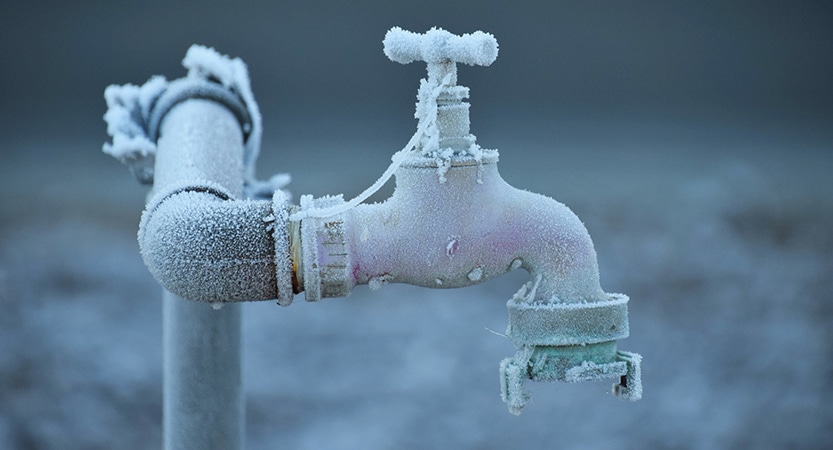How to Defend Your Pipes from Freezing: Expert Guidance
How to Defend Your Pipes from Freezing: Expert Guidance
Blog Article
Right here on the next paragraphs you will discover a lot of good quality advice in regards to 6 Ways to Prevent Frozen Pipes.

Cold weather can wreak havoc on your pipes, particularly by freezing pipes. Here's exactly how to prevent it from occurring and what to do if it does.
Introduction
As temperature levels decrease, the risk of frozen pipelines boosts, possibly causing pricey repair work and water damage. Understanding how to avoid frozen pipelines is vital for house owners in cool environments.
Prevention Tips
Protecting vulnerable pipes
Cover pipes in insulation sleeves or utilize heat tape to safeguard them from freezing temperatures. Concentrate on pipelines in unheated or outside locations of the home.
Heating strategies
Keep interior spaces adequately warmed, specifically areas with plumbing. Open up closet doors to permit warm air to circulate around pipes under sinks.
How to recognize icy pipes
Seek lowered water circulation from taps, uncommon smells or sounds from pipes, and visible frost on subjected pipelines.
Long-Term Solutions
Architectural modifications
Take into consideration rerouting pipes away from exterior walls or unheated locations. Add added insulation to attic rooms, cellars, and crawl spaces.
Upgrading insulation
Buy premium insulation for pipes, attic rooms, and walls. Proper insulation aids maintain consistent temperature levels and decreases the risk of frozen pipelines.
Shielding Outdoor Pipes
Yard pipes and exterior taps
Separate and drain yard hoses before winter months. Mount frost-proof faucets or cover exterior faucets with protected caps.
Recognizing Frozen Pipelines
What causes pipelines to ice up?
Pipelines ice up when revealed to temperature levels below 32 ° F (0 ° C) for extended periods. As water inside the pipelines ices up, it broadens, taxing the pipeline walls and potentially creating them to rupture.
Threats and problems
Icy pipelines can cause water supply disruptions, property damage, and pricey fixings. Ruptured pipelines can flood homes and create comprehensive architectural damages.
Signs of Frozen Water Lines
Determining frozen pipes early can avoid them from bursting.
What to Do If Your Pipes Freeze
Immediate actions to take
If you think icy pipelines, maintain taps available to relieve pressure as the ice thaws. Use a hairdryer or towels soaked in hot water to thaw pipes slowly.
Final thought
Protecting against frozen pipes requires aggressive procedures and quick responses. By understanding the reasons, indicators, and safety nets, house owners can safeguard their plumbing during winter.
6 Proven Ways to Prevent Frozen Pipes and Protect Your Home
Disconnect and Drain Garden Hoses
Before winter arrives, start by disconnecting your garden hoses and draining any remaining water. Close the shut-off valves that supply outdoor hose bibs and leave the outdoor faucet open to allow any residual water to drain. For extra protection, consider using faucet covers throughout the colder months. It’s also important to drain water from any sprinkler supply lines following the manufacturer’s directions.
Insulate Exposed Pipes
Insulating your pipes is an effective way to prevent freezing. Pipe insulation is readily available at home improvement stores and is relatively inexpensive. Pay close attention to pipes in unheated areas such as the attic, basement, crawl spaces, or garage. Apply foam insulation generously to create a buffer against the cold. You can also wrap your pipes in heat tape or thermostat-controlled heat cables for added warmth.
Seal Air Leaks
Inspect your home for any cracks or openings that could let in cold air. Seal any holes around the piping in interior or exterior walls, as well as the sill plates where your home rests on its foundation. Additionally, make sure to keep your garage door closed unless you’re entering or exiting. Leaving it open creates a significant air leak that can lead to frozen pipes.
Allow Warm Air Circulation
During cold snaps, it’s essential to allow warm air to circulate evenly throughout your home. Leave interior doors ajar to promote better airflow. Open kitchen and bathroom cabinets to help distribute heat consistently around the rooms. If you have small children or pets, be sure to remove any household chemicals or potentially harmful cleaners from open cabinets for safety.
Let Faucets Drip
A small trickle of water can make a big difference in preventing ice formation inside your pipes. When temperatures drop significantly, start a drip of water from all faucets served by exposed pipes. This continuous flow helps prevent the water from freezing. Additionally, running a few faucets slightly can relieve pressure inside the pipes, reducing the chances of a rupture if the water inside does freeze.
https://choateshvac.com/6-proven-ways-to-prevent-frozen-pipes-and-protect-your-home/

Do you like more info about Prevent Frozen Pipes ? Give a remark down below. We will be glad to find out your thoughts about this review. In hopes to see you back again later on. Appreciated our write-up? Please quickly share it. Help somebody else find it. Thanks for being here. Don't hesitate to check our site back soon.
Explore Now Report this page